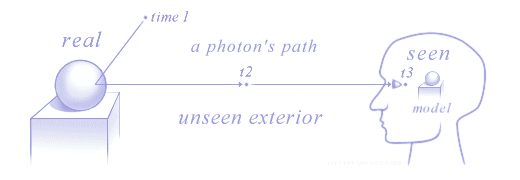[Editor’s note: This was originally published as a Secular Web Feature in 2000.]
Paranormal experiences that transcend the perceived confines of the body, such as out-of-body experiences, may be seen as evidence of the existence of a “spiritual body” that can exceed the confines of the physical body. The following, however, provides a simple neurological explanation for such paranormal experience.
The Internal World Model
Looking at the computer screen before you, you assume the screen you’re seeing is external to you. However, because all that you perceive is in fact data that have already entered the interior of your skull, what you perceive as external is a neurologically constructed model inside your brain of the real world outside your brain.

You never perceive the external world directly, you only perceive second-hand “messages” sent via photons and sound waves that have already struck your sensory apparatus and sent information about the external world into your brain where it was processed into the three-dimensional model of the real world that you see. The things that you perceive as being the genuine articles “out there” are actually simulations of them inside your brain.

Amazing as it seems, this means that what you think of as your body is actually a simulation body walking around your brain’s model of the world! So long as your internal model is exact, you can interact with the real world without problem. However, if and when the accuracy of your internal world model is compromised, paranormal, insane, or unsober experience is the result.
Because the perceived parameter of your body is a computational construct of your brain, it can be altered by abnormal brain activity. For example, the neurological program that places you, the observer, in one location in the model could just as well place you at any other location in the model, thereby creating an out-of-body experience. Or the location of your consciousness could appear to expand and engulf the entire world-model, resulting in a “cosmic consciousness” experience. Or, inside your brain’s program, experiences like pain could be placed in a location outside your simulated body, such as in the perceived location an amputated leg used to be, resulting in a “phantom pain” apparently outside your body. In each example, only the parameters of a simulated body inside the brain are transcended, and thus the evidence of a spirit body disappears like a ghost.
Conclusion: In comprehending the nature of out-of-body experiences there’s one thing we can know for sure: the fact that all observed data have already entered the skull of the observer leaves no room for doubt that the world you perceive including your perceived body is a simulation inside your brain of the real world outside your brain. The real world is thus never directly perceived. One explanation for out-of-body experiences is that the observer, or consciousness, moves outside the physical body via a spirit body. However, the physical evidence indicates that the spirit-body theory rests on the illusion that the observer’s perceived body and environment are the real thing rather than a model inside the observer’s brain, wherein, as a result of neurological anomalies, an observer can transcend the limits of his perceived body without actually transcending the limits of his real physical body.



